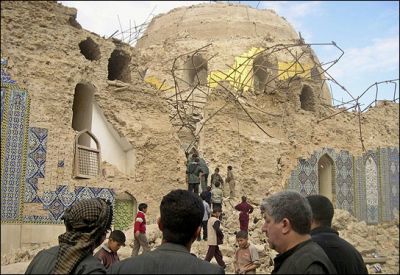 It is hard to spend eight hours jammed into those tiny, tiny seats that Virgin Atlantic uses in its economy class without talking to the person next to you. Yesterday, flying from London, I was seated next to an articulate Internet professional from Pakistan who was raised in Germany and now works on many projects here in America.
You talk about the World Cup and the insanity of penalty kicks deciding everything. You talk about why you are traveling and, of course, this often leads to talking about work. As an IT professional, he was interested in Internet content issues and, as a result, we spent some time talking about GetReligion. He asked what kinds of issues we cover. I said that one of the big questions, right now, is why American media are doing next to nothing to explain the roots of Sunni vs. Shiite violence in Iraq.
It is hard to spend eight hours jammed into those tiny, tiny seats that Virgin Atlantic uses in its economy class without talking to the person next to you. Yesterday, flying from London, I was seated next to an articulate Internet professional from Pakistan who was raised in Germany and now works on many projects here in America.
You talk about the World Cup and the insanity of penalty kicks deciding everything. You talk about why you are traveling and, of course, this often leads to talking about work. As an IT professional, he was interested in Internet content issues and, as a result, we spent some time talking about GetReligion. He asked what kinds of issues we cover. I said that one of the big questions, right now, is why American media are doing next to nothing to explain the roots of Sunni vs. Shiite violence in Iraq.
The Pakistani man said the roots do not matter. Nothing matters, he said, "because they are all insane. You cannot explain insane people."
But that is not, I said, the way that the people involved in the violence would explain what is happening, is it? He said, no, they would talk about grievances, many in the present, but many more in the past. And, yes, they would talk about how their competing Islamic beliefs clash.
Which, of course, brings us to the front pages of today's newspapers -- with another wave of violence in Iraq that killed 50 or so and left tortured bodies in the streets. It's that same old same old. The lead Washington Post story is a logical place to start. Here's one of the key passages:
Sectarian killings escalated sharply across Iraq after a bomb destroyed a revered golden-domed Shiite shrine in Samarra on Feb. 22. The bombing prompted reprisal attacks on Sunni mosques and pushed the country further toward all-out civil war.
In Baghdad on Sunday, the armed men, some wearing masks and dressed in black, descended on the al-Jihad neighborhood in buses after sunrise. They set up checkpoints along a main commercial street, demanded identification cards from passersby and burst into homes to single out Sunni Arabs to kill, residents said.
One resident, Hazim al-Rawi, said he gathered up his family and fled the neighborhood after he saw 15 bodies outside his home.
"Some of them were tortured with drills," he said of the bodies. "Some of them were hanged by ropes."
 If you read the story you will, perhaps, be left with some of those old, familiar questions.
If you read the story you will, perhaps, be left with some of those old, familiar questions.
Why are Shiite attackers almost always dressed in black? What are the differences between a Sunni mosque and a Shiite mosque? How would a journalist walking down the street tell a Shiite neighborhood from a Sunni neighborhood? And, yes, what are the historic, doctrinal differences between these two competing Islams?
Now, please understand that this is a long news story in this day and age -- 1,200-plus words -- and the lead reporters, Joshua Partlow and Saad al-Izzi, are backed up by the work of special correspondents Bassam Sebti, K.I. Ibrahim, Naseer Nouri and Saad Sarhan. You can't tell me that none of these skilled reporters know the background material on Sunnis and Shiites. Some may have lived it. But for some reason editors have decided that Americans do not need to know this information.
There are moments when you can see hints, moments when the ghosts briefly appear in print.
Outside the morgue at the Yarmouk Hospital, a distraught woman wearing a red head scarf searched for her missing brother. At 7 a.m., she said, black-clad gunmen broke into her house and demanded to know the family's tribal name. When her brother responded "Jubour," one of the gunmen said, "You are definitely Sunnis."
"I swear on Hussein, I swear on Ali, that we are Shiites," her brother, Muzahim Salman, pleaded, referring to relatives of the prophet Muhammad who are revered by Shiites.
This is a life-and-death moment at the end of a gun.
This is the story. If these "relatives of the prophet Muhammad" are this important, it might be good if the editors of The Washington Post dedicated a bit more ink -- a few paragraphs, perhaps, or a sidebar -- to telling readers about them. Is that too much to ask?
